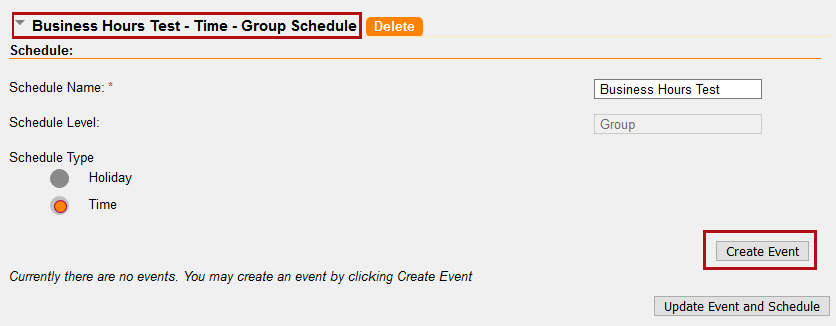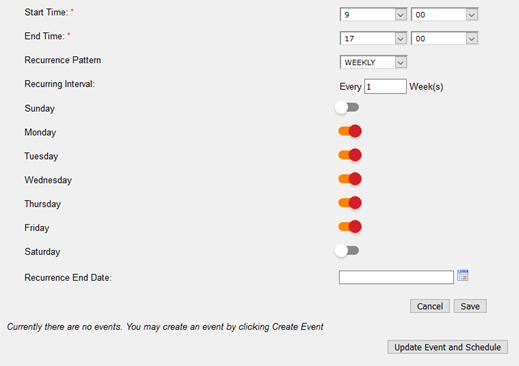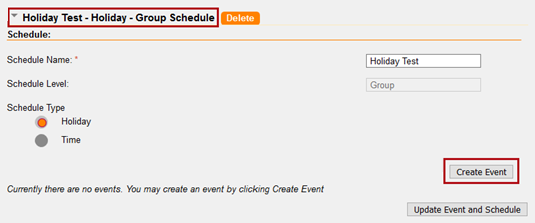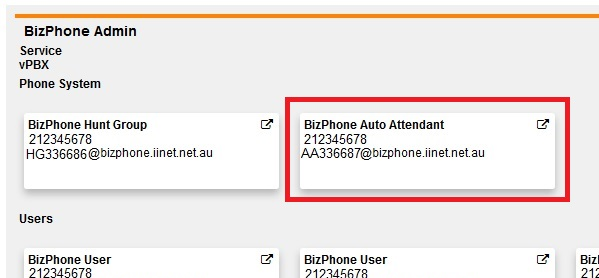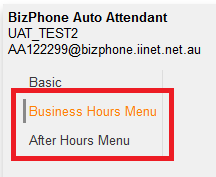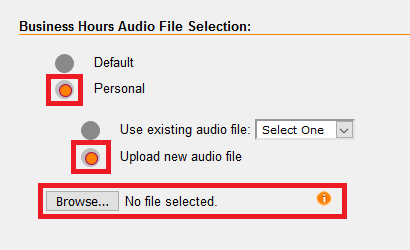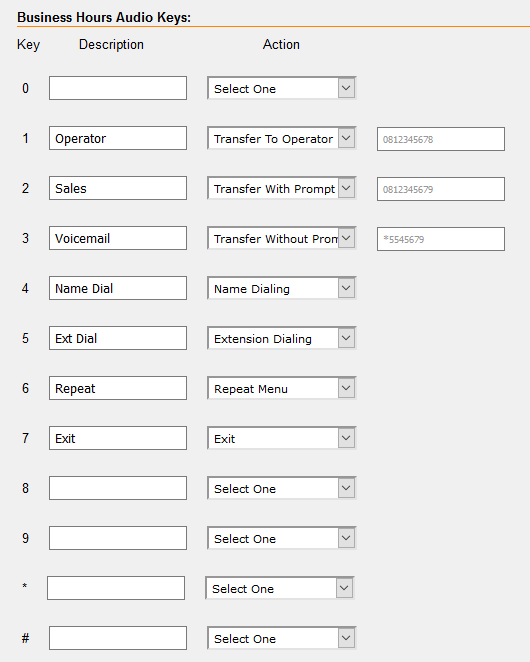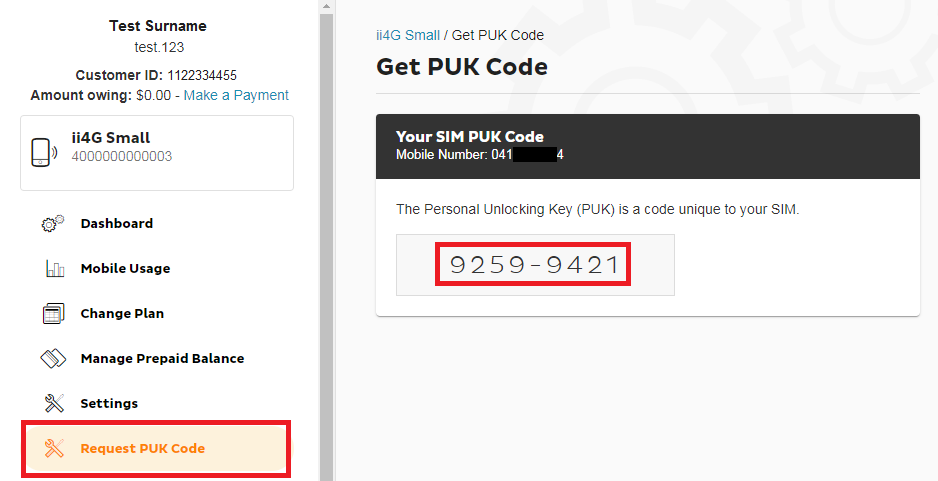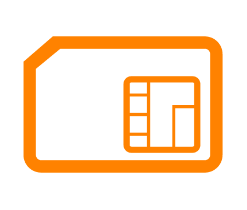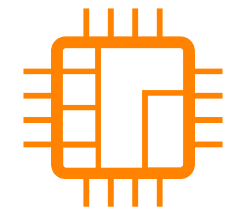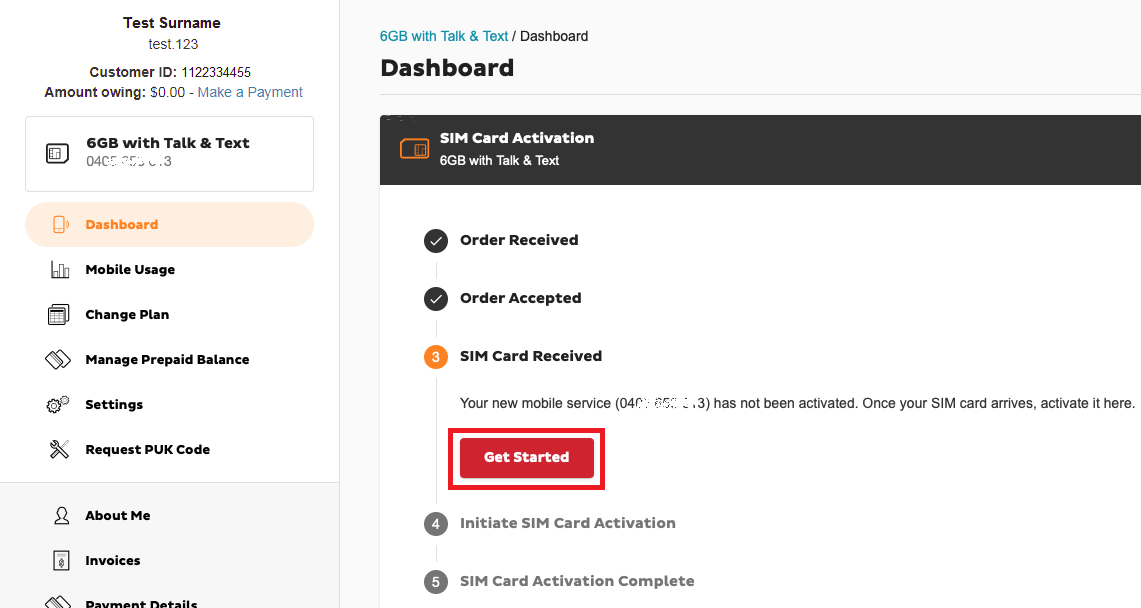Schedules and Events allows you to configure the following schedules for your BizPhone service:
- Business Hours schedules are set from business open to close, e.g. 9AM to 5PM.
- After Hours schedules are set outside of business hours. They should be split into AM (midnight to business open) and PM (business closed to midnight) events when created, e.g. 12AM to 8:59AM and 5:01PM to 11:59PM. It's also possible to create separate Weekend events.
- Holiday schedules are set for specific Public Holidays or holiday periods. While a holiday schedule is active, the Auto Attendant or Hunt Group performs After Hours or Busy treatment.
These schedules are used in a range of other BizPhone features, such as Auto Attendant, call forwarding and more.
Select one of the links below to jump to a query:
Creating a Schedule
- Log in to Frontier Portal. If you have never logged in before, please watch this video.
- Select the arrow next to Schedules and Events to expand the options.
- Under "Create Schedule", enter a Schedule Name.
- Select a Schedule Type:
- Time should be used for a Business Hours Schedule or After Hours Schedule.
- Holiday should be used for a Holiday Schedule. - Select Save to finish.
Business Hours/After Hours Events
- Log in to Frontier Portal. If you have never logged in before, please watch this video.
- Select the arrow next to Schedules and Events to expand the options.
- Select the desired schedule to expand the options, then select Create Event.
- Enter an Event Name. We recommend you include the days the event applies to, e.g. "Mon-Fri" for a Business Hours event.
Note: If creating an After Hours event, specify if this is the AM, PM or Weekend event. - Enter today's date as both the Start Date and End Date, and ensure the All day event switch is set to OFF (unless you are creating an After Hours Weekend event, then keep it ON).
- Enter a Start Time and an End Time in 2400 hour time, e.g. 900 to 1700.
Note: If All day event is ON, enter random numbers for start and end time - these fields cannot be left blank. - Select a Recurrence Pattern - Weekly is the most common.
- Set the Recurrence Interval to 1.
- Turn ON the switches for each day of the week you want the event to apply for.
- Leave Recurrence End Date blank if you want the event to continue indefinitely, otherwise specify an end date.
- Select Save.
- Select Update Event and Schedule to finish.
Holiday Events
- Log in to Frontier Portal. If you have never logged in before, please watch this video.
- Select the arrow next to Schedules and Events to expand the options.
- Select the desired schedule to expand the options, then select Create Event.
- Enter an Event Name, e.g. "Christmas".
- Enter the Start Date and End Date for the holiday period.
- Ensure the All day event switch is set to ON.
- Enter random numbers for Start Time and End Time - these fields cannot be left blank.
- Set the desired Recurrence Pattern. We recommend you set this to "Never" for holidays which change dates each year, such as the Easter holidays.
- Select Save.
- Select Update Event and Schedule to finish.
Further examples
Auto Attendant is a voice menu system that plays a recorded greeting to incoming callers and allows them to choose to be directed to an internal extension. For example, callers could dial 1 to speak with Sales, or 2 to speak with the Help Desk.
Select one of the links below to jump to a query:
Basic Auto Attendant Settings
- Log in to Frontier Portal. If you have never logged in before, please watch this video.
- Select BizPhone Auto Attendant. Basic settings will display by default.
- Under "BizPhone Auto Attendant", ensure the Set Active switch is set to ON.
- If you have not already done so, follow the steps in BizPhone Schedules and Events to set up your business hours and any desired holiday schedules.
- Set the desired Holiday Schedule. While a Holiday Schedule is in effect, your Auto Attendant will automatically use your After Hours Menu.
- Set the desired Office Hours.
- Every Day All Day will ensure that the Business Hours Menu is always used.
- Business Hours will use the Business Hours Menu during the scheduled business hours, and the After Hours Menu after that. - If desire, set the Activate Voice Mail Feature switch to ON. See the advice in BizPhone voice mail setup for more information about configuring voice mail.
Note: We recommend using a BizPhone User's voicemail rather than the Auto Attendant's voice mail, as Auto Attendant voice mail access is limited to dialing *62 and entering the voice mail passcode. If you don't know your passcode, please watch this video. - Select Update to save.
Business Hours/After Hours Menu Settings
- Log in to Frontier Portal. If you have never logged in before, please watch this video.
- Select BizPhone Auto Attendant.
- Select Business Hours Menu or After Hours Menu.
- Under "Business Hours/Afters Hours Audio File Selection", select Personal to upload custom audio.
- To select a previously uploaded audio file, select Use existing audio file, then select the file from the drop-down menu.
- To upload new audio, select Upload new audio file, then Browse and select the audio file to upload.
Note: Click the information icon to get a list of accepted file formats. - Select Update to save.
- Next, you'll need to set up your menu. Under "Business Hours/Afters Hours Audio Keys", you'll see a list of entries from 0-9 plus * and #, representing the keys on phone handset.
Note: Entries will be announced in numerical order - leave an entry blank if you do not wish for it to be included in your menu. - Each entry can be assigned a specific Description and Action:
- Transfer to Operator will announce "Transferring to operator" before transferring to the destination number. When this option is present in the menu, calls will be forcibly transferred to the operator if a menu item is not selected within 10 seconds.
- Transfer with Prompt will announce "Your call is being transferred, please hold" before transferring to the destination number.
- Transfer without Prompt will immediately transfer to the destination number without an announcement.
- Name Dialing will transfer the customer to the automated name directory where the name of a BizPhone user can be stated, and the system will dial through to that user. If used, we recommend you return to the Basic settings and select Last + First or First + Last under "Scope of Dialing" to allow users to state names in any order.- Extension Dialing will prompt the customer for an extension (i.e. the last five digits of a BizPhone number) and the system will dial through to that extension.
- Repeat Menu will repeat the Auto Attendant menu from the beginning. If used, we recommend this option is placed at the end of the menu (or just before the Exit option, if applicable).
- Exit will terminate the call. If used, we recommend this option is placed at the end of the menu. - If you wish to have a menu entry direct to voice mail, select Transfer With Prompt or Transfer Without Prompt, then set the destination number as *55, followed by the last 5 digits of the Auto Attendant or BizPhone user's phone number, e.g. "*5545679".
- Select Update to save your changes.
Further examples
- Ensure that your internet connection is online. Select your broadband service from the iiHelp menu to get troubleshooting guides for iiNet broadband connections.
- DND (Do Not Disturb) mode may be enabled on your ATA. To turn this off, lift the handset and dial *79, then hang up.
- Confirm that your ATA is registered by following this guide.
- Check your ATA is getting an IP address by lifting a connected handset and dialling *** to access the IVR menu. When you hear the “Enter the menu“ prompt, dial 02 and the IPv4 address will be announced.
- Turn your modem off for at least 10 seconds, then turn it back on and wait for the lights to settle.
- Restart your ATA by disconnecting the power and Ethernet cables for 10 seconds, then reconnect.
- Try using an alternate Ethernet cable between your ATA and modem.
- Is your network set up to deliver static IP addresses to connected devices? BizPhone hardware must be assigned an IP address via DHCP.
- Factory reset your handset by holding the OK button for 10 seconds.
- Run the BizPhone connection test and make a note of the test result number from both the Speed and VoIP tests.
- If you are unable to improve the audio quality of your BizPhone service, please email bizsupport@iinet.net.au with your call notes and test result numbers, and reference this troubleshooting article.
- Ensure that your internet connection is online. Select your broadband service from the iiHelp menu to get troubleshooting guides for iiNet broadband connections.
- DND (Do Not Disturb) modem may be enabled on your handset. Press the OK button then select Call Features > Do Not Disturb. If necessary, use the left and right arrow keys to toggle to "Disable", then Save.
- Confirm that your handset is registered by following this guide.
- Press and hold the OK button on your handset and select the Status tab to confirm that an IPv4 address is listed.
- Turn your modem off for at least 10 seconds, then turn it back on and wait for the lights to settle.
- Restart the handset by disconnecting its power and Ethernet cables for 10 seconds, then reconnect.
- Try using an alternate Ethernet cable between your modem and the handset base station.
- Is your network set up to deliver static IP addresses to connected devices? BizPhone hardware must be assigned an IP address via DHCP.
- Factory reset your handset by pressing the OK button, then select Settings > System settings > Base reset and enter the PIN "0000". When the handset resets, it will automatically download the configuration from the BPX server.
- Run the BizPhone connection test and make a note of the test result number from both the Speed and VoIP tests.
- If you are unable to improve the audio quality of your BizPhone service, please email bizsupport@iinet.net.au with your call notes and test result numbers, and reference this troubleshooting article.
- Ensure that your internet connection is online. Select your broadband service from the iiHelp menu to get troubleshooting guides for iiNet broadband connections.
- Check the DND (Do Not Disturb) status on your handset screen. Press the DND soft key to turn this off if necessary.
- Confirm that your handset is registered by following this guide.
- Press and hold the OK button on your handset to view connection options, and confirm that an IPv4 address is listed.
- Turn your modem off for at least 10 seconds, then turn it back on and wait for the lights to settle.
- Restart the handset by disconnecting its power and Ethernet cables for 10 seconds, then reconnect.
- Try using an alternate Ethernet cable between your handset and modem.
- Is your network set up to deliver static IP addresses to connected devices? BizPhone hardware must be assigned an IP address via DHCP.
- Factory reset your handset by holding the OK button for 10 seconds.
- Run the BizPhone connection test and make a note of the test result number from both the Speed and VoIP tests.
- If you are unable to improve the audio quality of your BizPhone service, please email bizsupport@iinet.net.au with your call notes and test result numbers, and reference this troubleshooting article.
- Ensure that your internet connection is online. Select your broadband service from the iiHelp menu to get troubleshooting guides for iiNet broadband connections.
- Check the DND (Do Not Disturb) status on your handset screen. Press the DND soft key to turn this off if necessary.
- Confirm that your handset is registered by following this guide.
- Press and hold the OK button on your handset to view connection options, and confirm that an IPv4 address is listed.
- Turn your modem off for at least 10 seconds, then turn it back on and wait for the lights to settle.
- Restart the handset by disconnecting its power and Ethernet cables for 10 seconds, then reconnect.
- Try using an alternate Ethernet cable between your handset and modem.
- Is your network set up to deliver static IP addresses to connected devices? BizPhone hardware must be assigned an IP address via DHCP.
- Factory reset your handset by holding the OK button for 10 seconds.
- Run the BizPhone connection test and make a note of the test result number from both the Speed and VoIP tests.
- If you are unable to improve the audio quality of your BizPhone service, please email bizsupport@iinet.net.au with your call notes and test result numbers, and reference this troubleshooting article.
Please select your handset to view the troubleshooting guide:
If your handset is not listed here, please contact us for assistance.
If you ever see a SIM Error message on your phone, here's what to do - including how to get your Personal Unlocking Key (PUK).
Select one of the links below to jump to a query:
- "Enter PUK" message
- "Insert SIM" or "SIM error" message
- "SIM card Rejected" message
- "Insert Correct SIM", "SIM card is locked" or "Enter subsidy password" message
"Enter PUK" message
This message indicates that your PIN has been incorrectly entered a number of times and you have been locked out of your device. You’ll need to enter your PUK code to use your SIM.
Note: PUKs are not available for eSIMs. Please request an eSIM Swap to get a new SIM.
- If you have a physical SIM, log in to Toolbox.
Please note: Your one-time password to log into Toolbox is sent to the mobile number listed in the contact details for your iiNet account. If you can’t use this mobile number because the SIM is locked, use another phone to call us on 13 22 58 and we’ll help you out. - Select Request PUK Code to get your Personal Unlocking Key so you can enter it on your mobile handset.
- If you see an error message like “SIM Rejected”, this means that a PUK has been entered incorrectly more than 10 times, and the SIM has been wiped.
- A wiped SIM cannot be recovered. If your SIM has been wiped, you’ll need to request a replacement SIM.
"Insert SIM" or "SIM error" message
An ‘Insert SIM’ or ‘SIM error’ message may indicate that your SIM:
- Has not been inserted correctly.
- Is damaged and cannot be read.
- Is the incorrect SIM size for your device.
Different devices use different sized SIM cards. We don't recommend cutting down your SIM or using a SIM adaptor. If you require a different SIM, please request a replacement SIM.
"SIM card Rejected" message
Your SIM will be permanently wiped if the PUK is entered wrong more than 10 times. You’ll need to request a replacement SIM.
"Insert Correct SIM", "SIM card is locked" or "Enter subsidy password" message
These messages mean that your phone is locked to a non-Vodafone carrier like Telstra or Optus. You'll need to contact the seller to get your phone unlocked.
Note: We can't unlock phones for you.
Which type of SIM are you activating?
| Physical SIM | eSIM |
|---|---|
Important: Your mobile handset must not be locked to a specific provider. We cannot unlock handsets.
Select one of the links below to jump to a query:
- Which type of SIM are you activating?
- Activate your physical SIM yyy
- Activate your eSIM yyy
- Troubleshooting
Activate your physical SIM yyy
- Wait for your SIM to arrive before you attempt to activate.
- Log in to Toolbox.
If you're activating a new Mobile number and don't have alternative mobile number to receive your passcode to log in to Toolbox, please call us on 13 22 58 to verify your identity and activate your SIM. - Select Get Started.
- New mobile numbers and replacement SIMs typically activate within a few hours, but please allow up to 48 hours for SIM activation.
- If you’re porting your mobile number to iiNet from another provider, make sure your current mobile service is active and ready to receive an SMS. Tick the checkboxes and hit Activate SIM Card.
- A porting authorisation SMS will be sent to your mobile number. Enter the code and click Verify Code.
-
The porting process will take approximately 3 hours and will only occur during these times:
Monday to Friday: 8 AM to 8 PM AET
Saturday: 10 AM to 6 PM AET - Keep using your old SIM until it stops working, then that's your cue to switch to your new iiNet SIM.
If you have any issues, please call us on 13 22 58 and we'll be happy to help.
Activate your eSIM yyy
- Make sure you have access to:
- Your compatible mobile handset (to scan the eSIM QR code); and
- Another device such as a computer, laptop or tablet (to display the eSIM QR code).
Note: It’s best if both devices are connected to Wi-Fi. If you only have your compatible mobile handset, please see this advice.
- Use your other device to log in to Toolbox and select Start Activation on the dashboard, then follow the prompts.
- If you’re transferring your number to iiNet, tick the checkboxes and select Transfer My Number Now. An authorisation code will be sent to your old SIM by SMS. Enter this code and select Verify Code.
- Select Send Confirmation Code SMS, then use your mobile handset to scan the eSIM QR Code.
- Follow the prompts on your handset screen to set up your new plan and enter your confirmation code, then your new service should be ready in 15 minutes, or within 3 hours if you’re transferring your number. You may need to restart your handset afterwards.
For more information about using your eSIM once it’s activated, see eSIM Management. - If you’re transferring your mobile number to iiNet:
- You may notice a different mobile number in your eSIM profile while your number transfer is still underway.
- Do not delete your eSIM profile as it will prevent a successful number transfer.
- If the correct mobile number isn’t showing after 3 hours and restarting your phone, please call us on 13 22 58 for assistance. iPhone users can also try these steps.
- Your old SIM will stop working once eSIM activation is complete.
If you couldn’t activate your eSIM
Please find your mobile device’s EID then call us on 13 22 58 and we'll be happy to help.
Troubleshooting
How to install an eSIM if you don’t have access to another device
If you don’t have access to another device such as a computer, laptop or tablet to display the eSIM QR code so that you can scan it using your compatible mobile handset:
- Use your handset to log in to Toolbox and access your eSIM details.
- You can then use one of the following options:
- Select Print QR Code to print on a personal/work printer or seek printing services at your local post office or library. You can then use your handset to scan the printed QR code.
- Write down the eSIM details shown below the QR code, then enter the eSIM details manually in your handset settings. Please visit the manufacturer’s website for support information if you’re not sure how to do this.
- Select Email QR Code to send a copy of the eSIM QR code to the contact email address on your iiNet account. You can then access your email on another device such as a public computer at your local library, then use your handset to scan the eSIM QR code.
Always log out of your email account at the end of your session on a public computer. - Be sure to dispose of any printed or written eSIM details securely once you’re done.
How to update the mobile number in an iPhone eSIM profile
- Open the Settings app and select Phone > My Number.
- Tap Edit, enter your mobile number, and then tap Save.
- If the wrong mobile number is still showing in your SIM profile, return to the Settings app and select Apple ID > Name, Phone Numbers, Email.
- Tap Edit and select Add email or phone number.
- Add your mobile number and delete the old mobile number.
- Restart your iPhone.
- Open the Settings app and select Messages > Send & Receive. Your SIM profile should now be working with the correct mobile number.
- If the issue persists, please call us on 13 22 58 for assistance.
How to find your mobile device’s EID
An Embedded Identity Document (EID) is a unique 32-digit number that can be found in your device settings.
iPhone
- Go to Settings > General.
- Choose About > EID and your EID will be shown.
Samsung
- Go to Settings > About Phone.
- Choose Status Information > EID and your EID will be shown.
- Go to Settings > About Phone.
- Choose SIM status > EID and your EID will be shown.
OPPO
- Go to Settings > About device.
- Choose Status > EID and your EID will be shown.
Here's everything you need to know about the different features available for iiNet Mobile. You can manage these features through Toolbox, and Quick Codes that you can dial from your phone.
Note: Premium SMS/MMS services are not available on iiNet Mobile.
Select one of the links below to jump to a query:
- Voicemail
- How to get your Voicemail messages
- How to turn Voicemail on or off
- Voicemail first-time setup
- Voicemail notification methods
- Do Voicemail messages expire?
- Call Barring
- Call Forwarding
- Manage all types of Call Forwarding in Toolbox
- Manage Call Forwarding Always with Quick Codes
- Manage Call Forwarding if Busy with Quick Codes
- Manage Call Forwarding if Unreachable with Quick Codes
- Manage Call Forwarding if No Reply with Quick Codes
- Caller ID
- Call Waiting
- Extend your mobile ring time
Voicemail
How to get your Voicemail messages
- To access voicemail, call 121 from your mobile handset.
- Alternatively, you may call 0414121121 from another phone and follow the prompts. Enter your mobile number and voicemail PIN.
- To access voicemail while overseas, call +61414121121 and follow the prompts. enter your mobile number and voicemail PIN.
How to turn Voicemail on or off
- Log in to Toolbox and select Settings.
- Use the ON/OFF switch to turn Voicemail on or off. Changes will be saved automatically and may take up to 5 minutes to apply.
Note: To fully disable Voicemail, you'll also need to dial "##002#" from your handset to disable all call forwarding to Voicemail.
Voicemail first-time setup
- Call 121 from your mobile handset.
- Follow the prompts to set a 4 to 10-digit voicemail PIN. This PIN is required to access voicemail from another phone.
- Record your name to personalise the standard greeting.
- Select your state/territory to set your time zone.
- (Optional) Hold the line and follow the prompts to set a custom voicemail greeting and/or adjust your notification method.
Note: SMS alerts are enabled by default. - Hang up to finish.
Voicemail notification methods
- SMS Alert - Dial 1218 from your mobile handset to enable/disable.
- Ring Alert - No longer available as of 12 March 2024.
- Visual Voicemail (iPhones only) - Dial 1217 from your iPhone to enable/disable. You can manage your Visual Voicemail from your iPhone.
Do Voicemail messages expire?
Yes. New voicemail messages and messages saved in your mailbox will expire after 7 days. If you need to keep a message, you can save it for a further 7 days by pressing 2 while listening to the message. Once a message has expired it’s permanently erased and can’t be recovered.
Call Barring
- Log in to Toolbox and hit Settings.
- Select the + (plus) icon next to Call Barring to expand the options.
- Adjust the ON/OFF switches for Bar All Outgoing Calls or Bar All Outgoing International Calls as desired. Changes will be saved automatically and may take up to 5 minutes to apply.
Call Forwarding
Call Forwarding will forward calls to your mobile number to a different phone number according to these rules:
- Forward all calls
- Forward if busy
- Forward if no reply
- Forward if unreachable
Note: Standard call costs may apply when any call is forwarded to a new destination (excluding voicemail).
Manage all types of Call Forwarding in Toolbox
- Log in to Toolbox and hit Settings.
- Select the + (plus) icon next to Call Forwarding to expand the options.
- Adjust the ON/OFF switches for Divert All Calls, Divert if Busy, Divert if No Reply, or Divert if Unreachable as desired.
- To change where calls are forwarded to for each type of call forwarding, hit Edit and enter the phone number in the Divert To text box, then hit Save. Changes may take up to 5 minutes to apply.
Manage Call Forwarding Always with Quick Codes
- To check if Call Forwarding Always is on or off, dial *#21# from your phone.
- To turn on Call Forwarding Always, dial **21* before the number you want to forward calls to, followed by #.
- To turn off Call Forwarding Always, dial #21#.
Manage Call Forwarding if Busy with Quick Codes
- To check if Call Forwarding if Busy is on or off, dial *#67# from your phone.
- To turn on Call Forwarding if Busy, dial **67* before the number you want to forward calls to, followed by #.
- To turn off Call Forwarding if Busy, dial #67#.
Manage Call Forwarding if Unreachable with Quick Codes
- To check if Call Forwarding if Unreachable is on or off, dial *#62# from your phone.
- To turn on Call Forwarding if Unreachable, dial **62* before the number you want to forward calls to, followed by #.
- To turn off Call Forwarding if Unreachable, dial #62#.
Manage Call Forwarding if No Reply with Quick Codes
- To check if Call Forwarding if No Reply is on or off, dial *#61# from your phone.
- To turn on Call Forwarding if No Reply, dial **61* before the number you want to forward calls to, followed by #.
- To turn off Call Forwarding if No Reply, dial #61#.
Caller ID
Caller ID allows you to present or restrict your mobile phone number from being displayed when you are calling someone.
- You can turn Caller ID on or off in Toolbox, or by dialling 1571 from your phone.
- To hide your phone number for one call only, dial 1831 before the number you're calling.
- To show your phone number for one call only, dial 1832 before the number you're calling.
- Log in to Toolbox and hit Settings.
- Select the + (plus) icon next to Caller ID to expand the options.
- Adjust the ON/OFF switches for Send Calling Line Identification and/or Calling Line Identification Display as desired. Changes will be saved automatically and may take up to 5 minutes to apply.
Call Waiting
Call Waiting will play a tone if you get another call while you're already in a call. You can swap between two calls - if you get a third call, you'll need to hang up one of the first two calls.
- To check if Call waiting is on or off, dial *#43#.
- To turn on Call Waiting, dial *43#.
- To turn off Call Waiting, dial #43#.
Extend your mobile ring time
You can extend the ring time for incoming mobile calls to a maximum of 30 seconds, in increments of 5 seconds.
Dial **61*121** before the number of seconds to ring (e.g. 20, 25 or 30), followed by #.


